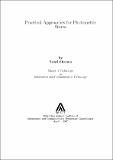Please use this identifier to cite or link to this item:
http://drsr.daiict.ac.in//handle/123456789/148| Title: | Practical approaches for photometric stereo |
| Authors: | Joshi, Manjunath V. Sharma, Swati |
| Keywords: | Computer vision Image reconstruction Image restoration Photometric |
| Issue Date: | 2007 |
| Publisher: | Dhirubhai Ambani Institute of Information and Communication Technology |
| Citation: | Sharma, Swati (2007). Practical approaches for photometric stereo. Dhirubhai Ambani Institute of Information and Communication Technology, ix, 58 p. (Acc.No: T00111) |
| Abstract: | In this thesis work, we aim to propose approaches for photometric stereo that are less time consuming and have low computational requirements. Many applications of computer vision require high resolution 3-D structure of the object and high resolution image in order to take better decisions. However, in practical scenario, the major requirement is to obtain these within the time limit specified by the application. In this thesis, we first consider the problem of estimating the high resolution surface gradients, albedo and the intensity field using photometric stereo. Assuming a Lambertian model, the surface gradients and the albedo are estimated using Least Square (LS), Constrained Least Square (CLS) and Total Least Square (TLS) approaches. High resolution depth map as well as image is then obtained using generalized interpolation. These methods are computationally less taxing and hence fast. A comparison of these methods with a regularization based approach is presented, which is computationally very expensive. <p/> <p/>We also propose a simple approach for estimating the light source position (which is generally assumed to be known) from a single image. The proposed method is based on the shading information in the images and does not require any calibration. <p/> <p/>Next we formulate a suitable regularization scheme for simultaneously estimating light source position, surface gradients and albedo given a number of images of a stationary object captured from a stationary camera by changing the light source position. The optimization is carried out using simulated annealing and graph cuts minimization techniques, to get better estimates for the illuminant position, surface gradients and albedo. Although simulated annealing guarantees global minima for any arbitrary energy function, it takes hours for convergence. This makes it inappropriate in practical situations. So, we also look into the use of graph cuts minimization method which converges very fast. We present a comparison of the performance of simulated annealing and graph cuts optimization methods. <p/> <p/>Our first approach for obtaining high resolution depth and image using LS, CLS and TLS minimization methods with generalized interpolation, does not use any regularization which becomes essential while estimating high resolution image intensities and depth values, which is an ill-posed problem. Finally, we estimate the superresolved image and depth map using photometric cue and graph cuts optimization using a discontinuity preserving prior. Our results show that the high resolution images reconstructed using our approach that uses graph cuts minimization are much superior as compared to the approaches that use general interpolation methods. |
| URI: | http://drsr.daiict.ac.in/handle/123456789/148 |
| Appears in Collections: | M Tech Dissertations |
Files in This Item:
| File | Description | Size | Format | |
|---|---|---|---|---|
| 200511009.pdf Restricted Access | 580.74 kB | Adobe PDF |  View/Open Request a copy |
Items in DSpace are protected by copyright, with all rights reserved, unless otherwise indicated.
